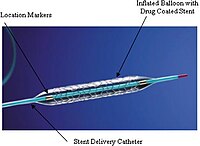
Photo from wikipedia
Purpose: Evaluate for normative postoperative magnetic resonance imaging (MRI) characteristics of a Baerveldt Glaucoma Implant (BGI). Design: Prospective case series. Participants: Seven subjects with uncontrolled glaucoma requiring a primary superotemporal… Click to show full abstract
Purpose: Evaluate for normative postoperative magnetic resonance imaging (MRI) characteristics of a Baerveldt Glaucoma Implant (BGI). Design: Prospective case series. Participants: Seven subjects with uncontrolled glaucoma requiring a primary superotemporal BGI. Methods: Subjects prospectively underwent sequential MRI orbital scans without contrast at 0 to 2 weeks, 6 to 8 weeks, and 4 to 6 months after implantation of a BGI model 103-250. Masked to the postoperative time course, a radiologist measured bleb and implant characteristics. Main Outcome Measures: Linear measurements of the maximum bleb height at the anterior, middle, and posterior sections of the endplate were measured. Intraocular pressure (IOP) was correlated to bleb height. Results: On axial T2-weighted images, the height of fluid below and above the BGI endplate increased from the initial to the final MRI images: 0.49 mm to 1.83 mm and 0.57 mm to 1.08 mm (middle 1/3), respectively. On coronal T2-weighted images, fluid below and above the BGI endplate increased from 0.47 mm to 1.53 mm and 0.49 mm to 1.38 mm, respectively. Maximum inverse correlation between bleb height and IOP was observed at the 6 to 8 week coronal T2 images (r=−0.963, P=0.002). Conclusions: Fluid collections and endplate characteristics are easily visualized with MRI. Dynamic changes occur over the early postoperative time course. Bleb height is inversely correlated to IOP at 6 to 8 weeks, but disappears at 4 to 6 months.
Journal Title: Journal of Glaucoma
Year Published: 2017
Link to full text (if available)
Share on Social Media: Sign Up to like & get
recommendations!